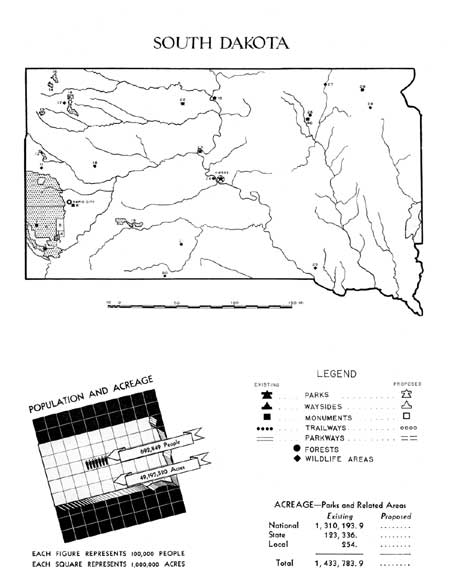|
National Park Service
A Study of the Park and Recreation Problem of the United States |

|
SOUTH DAKOTA
THE POPULATION is predominately rural; only 20 percent of the State's people live in cities, the largest of which is Sioux Falls, with a population of 33,362 in 1930. The eastern third of the State, because of soil and rainfall, contains the best agricultural land and the heaviest population. Estimates of the future population indicate that there is likely to be only a relatively small increase during the next 25 years.
Public provision for recreation on large natural areas has been some what meager except in the Black Hills region, where several national monuments and national forests and Custer State Park have been established.
Two counties and certain of the larger municipalities have provided recreation facilities for their inhabitants. There is need for recreation facilities in the smaller municipalities and rural centers. The lack of adequate local recreation areas and of a State park system is depriving South Dakota residents of desirable forms of recreation.
The one State park is too far removed from most of the State's inhabitants to be readily usable, although its natural beauty warrants its status. There are a number of areas of scenic and historic interest distributed over the State which merit inclusion in a State-wide State-park system.
South Dakota lies in the path of considerable tourist traffic, and what it has to offer in scenic beauty and recreation should not be neglected. The preservation and restoration of wildlife, and the expansion of fishing facilities will redound to the enjoyment and economic benefit of the residents of the State.

(click on image for an enlargement in a new window)
| FEDERAL | ||
| National park: | ||
| 3. Wind Cave | 12,639.7 | |
| National monuments: | ||
| 2. Fossil Cycad | 320 | |
| 7. Jewel Cave | 1,274.5 | |
| 19. Badlands | 150,103.4 | |
| Total | 151,697.9 | |
| Recreational demonstration area: | ||
| 4. Custer | 20,167.3 | |
| National forests: | ||
| 1. Harney | 517,021 | |
| 9. Black Hills | 491,714 | |
| 13. Custer | 70,808 | |
| Total | 11,079,543 | |
| National wildlife areas: | ||
| 12. Belle Fourche Wildlife Refuge | 13,680 | |
| 20. La Creek Migratory Waterfowl Refuge | 9,362 | |
| 25. Lake Andes Migratory Waterfowl Refuge | 362 | |
| 27. Sand Lake Migratory Waterfowl Refuge | 19,636 | |
| 29. Waubay Migratory Waterfowl Refuge | 2,586 | |
| Total | 45,626 | |
| Soil Conservation Service Land Development Projects: | ||
| 22. Little Moreau Project | 320 | |
| 23. Fort Sully Project | 200 | |
| Total | 2520 | |
| STATE | ||
| State park: | ||
| 5. Custer | 108,000 | |
| State monument: | ||
| 28. Fort Sisseton | 640 | |
| State wildlife areas: | ||
| 11. Theodore Roosevelt Game Refuge | ||
| 17. Antelope Game Preserve | 8,040 | |
| 18. Stoneville Game Refuge | 2,240 | |
| 21. Ander's Lake Game Refuge | 2,560 | |
| 24. Farm Island Game Refuge | 1,000 | |
| 26. Mina Lake Game Refuge | 856 | |
| Total | 14,696 | |
| LOCAL | ||
| Municipal parks: | ||
| 8. Rapid City (1 area) | 72 | |
| 10. Mobridge (1 area) | 22 | |
| 30. Aberdeen (1 area) | 160 | |
| Total | 254 | |
1 Area under Federal Administration June 1938.
2 Acreage developed for recreation as part of larger projects.
| <<< Previous | <<< Contents>>> | Next >>> |
park-recreation-problem/south_dakota.htm
Last Updated: 18-May-2016